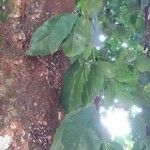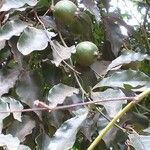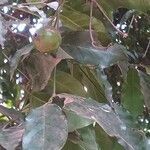Leaf blades 5.7–18 × 1.2–10 cm, elliptic to obovate-elliptic, apex distinctly acuminate, base cuneate, glabrous or less often glabrescent (?or very rarely pubescent) above, glabrescent or less often glabrous or pubescent beneath with denser appressed hairs on the nerves; domatia present; petiole 4–11 mm long, glabrescent to pubescent; stipules 2–12(15) mm long, triangular, long-acuminate, rusty pubescent to glabrescent outside, caducous leaving a line of hairs above the scar.
Corolla white to cream-coloured with dark brownish-red blotches, pubescent outside; tube 3–7.7 cm long, narrowly cylindrical below, funnel-shaped above, the funnel-shaped portion 1.8–5 cm long and 0.8–1.8 cm wide at the top, the cylindrical portion 0.3–0.8 cm wide, pubescent outside; lobes 1.2–4.5 × 0.8–1.8 cm, lanceolate, acuminate, sparsely to densely covered with short stiff hairs, overlapping to the right in bud.
A shrub or small tree. It grows 8-12 m tall. The small branches are hairy. The leaves are opposite and sword shaped. They are shiny and dark green. The flowers occur singly. They are trumpet shaped and in the axils of leaves. They are creamy white with red marks. The fruit are 3-8 cm long. They are round or oval. The seeds are black and 8 mm long by 6 mm wide.
Calyx sparsely pubescent to pubescent; tube 3–6(11) mm long, 5-angled; limb-tube 6–23 mm long, slightly wider than the tube, usually splitting for ± half the length; lobes 3–20(27) mm long, 1.5–4 mm wide at base, linear.
Fruit 2.5–7.6(?10.2) cm long, spherical to ellipsoid, sometimes slightly ribbed, glabrous, green, the calyx limb deciduous leaving a pale ± pentangular scar.
Shrub or small tree (1–2.5) 4–8.5(10–15) m tall; young stems slender, rusty pubescent or less often glabrescent.
Flowers solitary; peduncle very abbreviated; pedicel 3–7 mm long; bracteoles filiform.
Anthers exserted for ± one third of their length, 0.6–2.3 cm long.
Pollen presenter 1.2–2.6 × c. 0.5 mm, exserted.
A shrub or small tree, to 25 ft. or more high
Style 5–7.5 cm long, widening towards apex.
Corolla white, mottled purple within
Seeds up to 8 × 6 mm, blackish.




